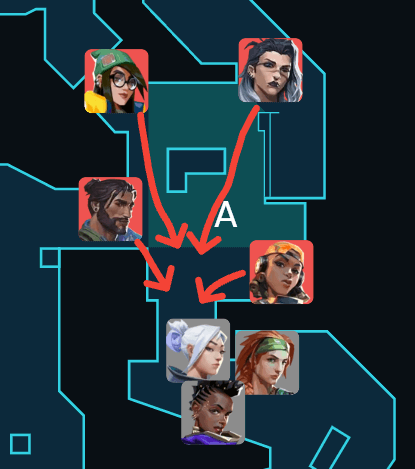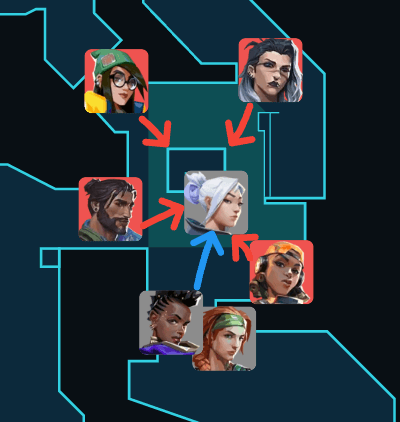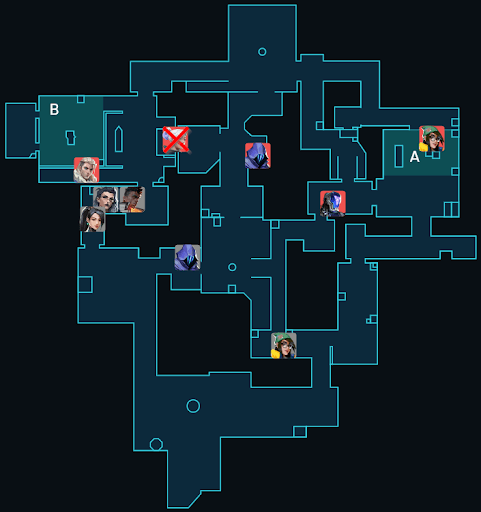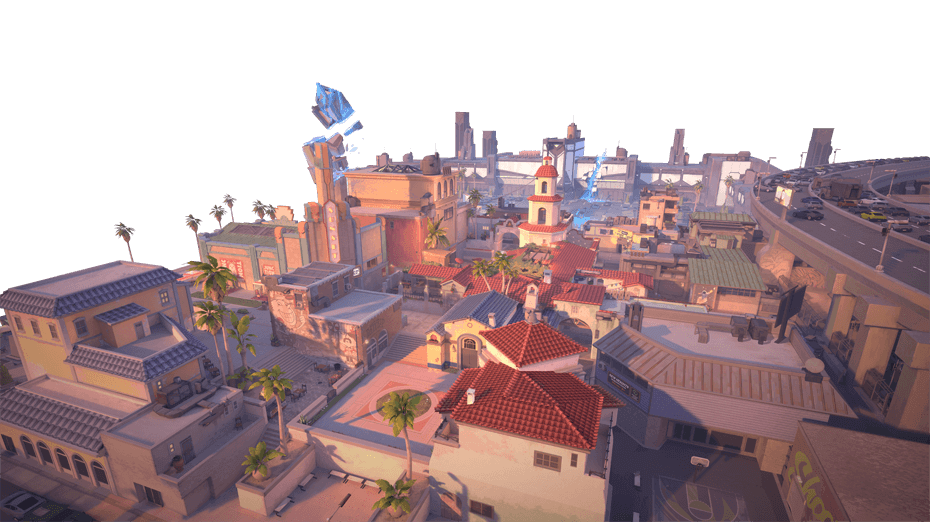How to Get Better at Playing VALORANT Duelists
This guide will give everything you need to know about playing duelist.
Many people think that the job of the duelist is to get the most kills, but there is much more nuance to the role than that.
From offense to defense and playing the different styles of agents that are within the role, this guide serves to help you get the most value out of playing duelist.
So stick around if you want to learn or get better at playing Jett, Neon, Phoenix, Raze, Reyna, and Yoru.
To learn lineups for duelists and all other agents, head to our Mobalytics VALORANT site.
The Duelist’s Role
The common misconception of duelists is that their job is to get the most kills. This is not the case, but is rather the result of a duelist doing their job well and the other members of the team setting them up to succeed.
Even if a duelist isn’t getting many kills they can be doing a great job and having much higher impact than the notorious lurking Reyna who is last alive in a 1v4 almost every round and gets 1 or 2 kills per round after it is already lost.
The true job of a duelist is to create space for their team to take ground for map control and to take favorable fights that only they can disengage from to get first bloods. What does creating space mean, and what does it do to help the team?
Creating space is moving deeper into a contested area which gives teammates behind more breathing room to enter into the contested zone. In Valorant the map design has many tight choke points that must be passed through to enter into sites. For example look at Pearl A site below.

There are tons of angles that defenders can play to watch one small area.
If the attackers come out of that area they are at a massive disadvantage due to how many more areas they have to clear while any defenders only have to watch one spot. Jett dashing into site breaks the angles the defenders are holding, and forces them to watch another area which allows the non-duelist players to move through the choke point more safely.
If Jett only uses dash to go into the middle of the site she’ll just die, but it at least creates space for her teammates to get through the choke point and with extra utility from Jett and her teammates she can survive and even get kills. More on that bit later on.

Duelist Attributes
Not all the agents who are duelists exactly play the same. There are a few styles and attributes that set them apart, but nonetheless their role is similar. Many of the duelists have multiple of these attributes.
Movement
The first attribute of some duelists are movement abilities. Raze and Jett fall into this category because of their ability to cover a big chunk of ground very quickly with Blast Packs and Tailwind respectively. Yoru has the attribute with his Gatecrash ability as he can teleport deep into sites to make space.
Neon loosely falls under this category as she can sprint and slide with High Gear. This group of duelists are able to get deep into sites on offense to draw defensive players’ crosshairs away from chokepoints. On defense they should be set up in off angles or one and done positions where only they can escape as well as for fast crunch plays.
Flash Entry
The other primary form of duelists are flash entry fragger duelists. These consist of duelists who have a flash that can be used for themself to enter into contested areas. Phoenix, Reyna, and Yoru all have this attribute as they have a flash they can use for themself to get through a chokepoint.
Neon is in here as well because she can do this with her Relay Bolt. On offense these duelists have to use their flash or stun to be the first one through a chokepoint. On defense these agents are great for trap play where they can hold and then throw a flash based on information of an enemy’s location.
Lurk
It is important to know that Yoru is the only duelists who consistently falls under this category. Any player can lurk, but it is highly recommended that the duelist is not the one to do it. Yoru is able to lurk well as his Gatecrash allows him to teleport back with the team to then entry after a lurk.
Coordination and Communication
Before getting to in depth explanations on strategy it is important to go over the importance of communication and coordination. In that scenario of Jett dashing into site to make space for her teammates there needs to be a lot of coordination for everything to go correctly, as it isn’t as simple as dashing in, getting a kill, then having your team win the rest of the round.
Coordination
Timing is everything when successfully playing off of teammates’ utility. As the duelist, you are the only agent who is able to effectively create space and play positions no other agents are able to. With help from support agents’ utility, the duelist is able to utilize these positions and support utility to get picks early in rounds and kills when entering.
Proper coordination ensures teammates get value from their utility. For example if a duelist and controller are not on the same page and the duelist is not ready to enter when smokes are down, the smokes are wasted and there is no longer a timing window to get on site.
This ends up as one of those scenarios where everyone is stuck in the chokepoint and the team finally goes in when the smokes are down and the entire enemy team who had time to rotate is there to mow the team down.
To avoid that situation, it is best accomplished with good communication.
Communication
It is very important to communicate a few things with your support players, because if you enter into the site without saying a word you will most likely be cannon fodder and no one will follow up on your death. If the duelist dies on an entry without saying anything and no one on their team is on site despite the sacrifice, it is the duelist’s fault.
Be sure to communicate these important things:
- When you are entering into a site
- Asking for smokes, flashes, recons, etc. before or as you are entering, need to get out of a tight situation, or when aggressing an area to give you the highest chance of success
- When you want to cancel – this one is very important as it prevents your teammates from wasting utility as they know you are not going in
Timing Windows
This is an important concept to know to get better at the game, but it is extremely important to know when playing duelist. This is because duelists set the pace of the game and need to know when to go in during the slight timeframe when the team has an advantage or when to wait.
The scenario in which there is a small window that needs to be acted on is easier to understand. An example scenario of this is when on offense and the team gets a pick on Jett who is playing market.
Knowing that Sova is on B because he shot a dart at the beginning of the round, this pick puts a non-sentinel player on an island. If there are teammates close by the duelist should then take advantage of the Sova most likely being alone and entering into site.
Even if Phoenix dies, he will most likely get traded out if he calls out that he is going in immediately. This is the play because going in immediately prevents any rotates from helping out the Sova who is alone. This is where knowing a timing window is very important and being proactive which allows you to enter into a site with only one person.
This really comes down to not being afraid to enter, a common problem duelist players have which costs their team rounds and games. Being confident in going in when the timing is right prevents getting stalled out once the timing window is gone and the enemy team has rotated.

Playing Offense
It has already been mentioned, but the main job of the duelist is to create space on offense by going first into a site as deep as possible to relieve pressure off of the chokepoint into site so support players who do not have entry and movement based utility are able to get out on to site.
Even if a duelist is being played that does not have movement options, space still needs to be made with a flash and moving out of a choke. This has a good chance of ending with a death, but it is for the greater good of the team in taking map control to get on to a site.
If space is created and the duelist is deep into site, there are two things that are best to do.
- Stay alive to pressure defenders on site
- Swing enemies who are hit by teammates’ utility and/or pressured by attackers in multiple locations
The first point of staying alive is important because as long as the duelist deep into site is alive defenders have to worry about the duelist in one location and supporting players in the choke point. This breaks the crosshair placement of defenders, and makes them watch two places at once.
The second point is how to open up sites and get the most kills as a duelist. Duelists are the only agents who can get deep into sites quickly enough to take advantage of supporting teammates’ utility that makes defenders stunned, flashed, vulnerable, revealed, etc. In the clip below, Demon1 as Jett does both of these things.
First he uses Tailwind to close in on the Sova who is flashed and spotted by the drone. Next he drops a Cloudburst on himself to stall, making the Killjoy have to worry about Demon1 swinging from the smokes and the rest of the attackers who are moving onto site with the space Demon1 created. Lastly Demon1 swings and kills Killjoy as his teammates are in lane while Killjoy is pressured from two locations.
Playing Defense
On defense Duelists should be trying to get early advantages and take fights from positions only they can play in without getting punished. During retakes and set plays early into rounds duelists play defense very similarly to how they should be playing offense by taking advantage of their space creating abilities to capitalize on enemies afflicted by support players’ utility.
During typical mid rounds duelists should be set up by using trap plays and/or playing off angles and various positions only a duelist can play without being punished. First let’s talk about trap plays.
Trap Plays
A trap play involves a set up using a status effect such as a flash, stun, vulnerable, etc. in a certain position based on information which will set up a player to kill the impacted enemies. The first bit is getting information. This can be done with Sentinel utility such as Killjoy’s Turret or Cypher’s Spycam.
Next is with initiator utility that gets information such as Sova’s Recon Bolt, Fade’s Prowler, or Skye Trailblazer. The last way is with a teammate jump spotting or jiggle peeking to continuously check an area from a safe location.
The next part is a piece of utility to punish the players who were spotted with the information. This can be with any flash or stun from an initiator, controller, or the duelist themself. Here are are to example trap plays:
The first example is simple and is between a Phoenix and a Cypher. The Cypher Trapwire in the lane down B Long. If the Trapwire is hit or shot out, Phoenix then throws a flash around the corner to flash the enemies in that location. This positioning of the Trapwire is ideal because enemies won’t be too close to Phoenix in case they are moving too fast, and there isn’t cover behind them they can quickly get into. The spot the Trapwire is in provides no cover or escape route for a flashed enemy.

The second one is a bit more elaborate as it has more moving pieces. This trap is done in the early round to kill a player in Tiles on Ascent. Sova starts it off by shooting a Recon Bolt towards Tiles. Information is gathered by a scan or an enemy shooting the dart. If the information confirms any players are there, Omen throws a Paranoia from B Main to tiles to nearsight them. Lastly Jett updrafts and dashes to Tiles to kill the blinded player(s). This is an example play that has information from Sova, a status effect from Omen’s Paranoia, and uses the movement of Jett to capitalize on the status effect.

Defensive Positioning
When playing a duelist it is important to take advantage of the fact that a duelist can play in so many different locations without getting punished that a regular agent would be left for dead in. It is imperative to not play in positions that any regular agent can play in and take advantage of the extra positions duelists can play in.
This is advantageous because these positions are typically unexpected and not properly cleared by the attackers, leading to easy kills a duelist can escape from without being traded. Even if the enemy does clear the position the duelist can still get out and it forces the enemy team to use extra utility to clear out all of the extra positions a savvy duelist can potentially play in.
Stop playing the same mundane positions that regular agents are limited to that attackers pre-aim and clear out with utility and start taking advantage of the unexpected positions duelists can get multiple kills and still escape from. For example, Reyna can play any off angle and dismiss after a kill to avoid being traded, Jett can dash out of a one-and-done position or when out in the open, Neon can throw up a Fast Lane to block vision and sprint away. In the clip below you can see Ethan taking advantage of Yoru’s Gatecrash to get out of a position that would result in a trade for any other agent.
Even other duelists would have trouble getting out of that position and shows the importance of knowing the duelist you are playing and their limitations. Not only was this smart to play this position with the only agent, but Ethan also played an off-angle within it and did not tuck himself into the corner as that location would more likely be hard-cleared. That is why EDG was not expecting a player to be in this position and slow walked right into Ethan’s crosshair.
Closing Thoughts
When measuring success of a duelist it is not a matter of how many kills are on the scoreboard. If a duelist is doing their job and the support utility is there, the duelist should be towards the top of the scoreboard. But there are plenty of scenarios where a duelist with very few kills is doing their job well making space or a duelist has a lot of kills and they are getting low impact kills and baiting their team. That latter situation is a common issue with many duelist players in lower elo.
If you’re losing games as a duelist with a lot of kills, there are a few things to assess. Look at how late into rounds these kills are coming in and if a lot of kills are in scenarios in which your team is already at a big disadvantage or if the round is essentially lost in a 1v3, 2v5, etc.
The final thing to take a look at is where everyone on the map is when you get your kills and deaths and make sure there is good spacing with your teammates and you’re not the one trading out support players who are positioned ahead of you.
This guide aims to lay the foundation of playing the duelist role properly. To take it to the next level it is a matter of mastery and knowing the limits and capabilities of your favorite duelist agent. Despite the agent you are playing, the fundamentals of the role are very similar as this guide lays out.
So be sure to make space for the team and be aggressive with taking fights to get early picks and advantages by taking high percentage fights from locations only duelists can play in.
 Download APP
Download APP Collapse
Collapse


